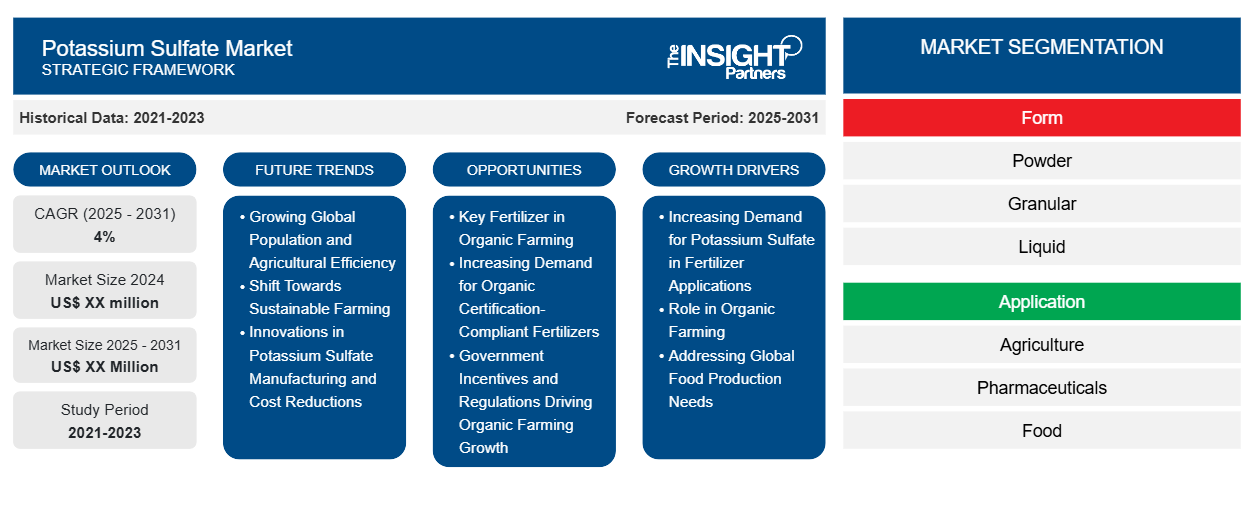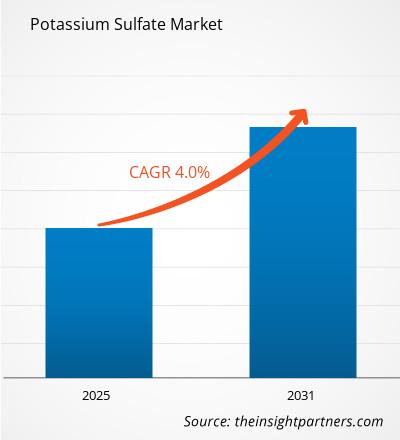The Potassium Sulfate Market is expected to register a CAGR of 4% from 2025 to 2031, with a market size expanding from US$ XX million in 2024 to US$ XX Million by 2031.
The report is segmented by By Form (Powder, Granular, and Liquid). The report is also segmented based on Application (Agriculture [Fruits and Vegetables, Grains and Cereasls, Oilseeds and Pulses, and Others], Pharmaceuticals, Food, Chemicals, Building and Construction, and Others). The report scope covers 5 regions: North America, Europe, Asia Pacific, Middle East and Africa, and South and Central America and key countries under each region. The global analysis is further broken-down at regional level and major countries. The Report Offers the Value in USD for the above analysis and segments.
Purpose of the Report
The report Potassium Sulfate Market by The Insight Partners aims to describe the present landscape and future growth, top driving factors, challenges, and opportunities. This will provide insights to various business stakeholders, such as:
- Technology Providers/Manufacturers: To understand the evolving market dynamics and know the potential growth opportunities, enabling them to make informed strategic decisions.
- Investors: To conduct a comprehensive trend analysis regarding the market growth rate, market financial projections, and opportunities that exist across the value chain.
- Regulatory bodies: To regulate policies and police activities in the market with the aim of minimizing abuse, preserving investor trust and confidence, and upholding the integrity and stability of the market.
Potassium Sulfate Market Segmentation
Form
- Powder
- Granular
- Liquid
Application
- Agriculture
- Pharmaceuticals
- Food
- Chemicals
- Building and Construction
You will get customization on any report - free of charge - including parts of this report, or country-level analysis, Excel Data pack, as well as avail great offers and discounts for start-ups & universities
Potassium Sulfate Market: Strategic Insights

-
Get Top Key Market Trends of this report.This FREE sample will include data analysis, ranging from market trends to estimates and forecasts.
Potassium Sulfate Market Growth Drivers
- Increasing Demand for Potassium Sulfate in Fertilizer Applications: The demand for fertilizers is increased due to the growing requirement for high-quality agricultural products. Potassium sulfate is among the best fertilizers for the demand, which is potassium-based, as it serves as an excellent source of potassium and sulfur, essential nutrients in plant growth and development.
- Role in Organic Farming: Organic farming is increasing due to which the demand for potassium sulfate also increases as it is most often used organic fertilizer. Potassium sulfate is usually preferred by organic farmers because it has a lower chloride content, and this is suitable for crops that are sensitive to chloride.
- Addressing Global Food Production Needs: The growth in the global population and the necessity to increase food production have increased the demand for potassium-rich fertilizers such as potassium sulfate. It helps improve crop yields and quality, thus being an important component in modern agricultural practices.
Potassium Sulfate Market Future Trends
- Growing Global Population and Agricultural Efficiency: Potassium sulfate market, one major trend driving the agricultural industry, due to the demand for K2SO4, being an important fertilizer. The main nutrient which this fertilizer offers is potassium to the plant; it's known to ensure robust root formation and drought tolerance as well as healthy growth in plants. With the rise in the global population, people need efficient agriculture practices that increase crop yields. The increased demand for potassium sulfate is hence likely to be sustained with this increase in global population.
- Shift Towards Sustainable Farming: In addition, the industry is shifting toward sustainable farming; this is seen to change the demand for potassium sulfate as compared to potassium chloride. Sulfate carries less chlorine, which would harm a sensitive crop; thus it is preferred to use a sulfate form when the cultivated crop is sensitive to chlorine content, such as tobacco and potatoes and fruits in many regions of the world.
- Innovations in Potassium Sulfate Manufacturing and Cost Reductions: Finally, innovations in potassium sulfate manufacturing processes are expected to impact the dynamics of the market. In this regard, companies will invest in technology that reduces the energy intensity and thus the cost of producing potassium sulfate. As the specialty fertilizer market is expanding, these improvements will lead to increased supply which may lead to lower prices thus making potassium sulfate more accessible to wider ranges of farmers across the world.
Potassium Sulfate Market Opportunities
- Key Fertilizer in Organic Farming: Organic farming is another emerging opportunity in the potassium sulfate market. Organic farmers prefer using organic fertilizer, and potassium sulfate has been perceived as an environmental-friendly substitute for synthetic fertilizer. With the rise of organic agriculture, demand in the market for potassium sulfate is expected to grow.
- Increasing Demand for Organic Certification-Compliant Fertilizers: The increased demand for organic products creates a need for fertilizers that are organic certification-compliant. As a naturally occurring mineral, potassium sulfate is an organic fertilizer that fits the bill and is thus an appealing choice for organic crop production. That it improves plant health and soil quality endorses its use in organic farming.
- Government Incentives and Regulations Driving Organic Farming Growth: Incentives and regulations from governments across the globe towards sustainable agriculture positively promote organic farming. This can be reflected in increased demand in areas where growth in organic agriculture is strong, owing to policy support. As more countries embrace organic farming, the opportunity for the potassium sulfate market is vast.
Potassium Sulfate Market Regional Insights
The regional trends and factors influencing the Potassium Sulfate Market throughout the forecast period have been thoroughly explained by the analysts at The Insight Partners. This section also discusses Potassium Sulfate Market segments and geography across North America, Europe, Asia Pacific, Middle East and Africa, and South and Central America.
Potassium Sulfate Market Report Scope
| Report Attribute | Details |
|---|---|
| Market size in 2024 | US$ XX million |
| Market Size by 2031 | US$ XX Million |
| Global CAGR (2025 - 2031) | 4% |
| Historical Data | 2021-2023 |
| Forecast period | 2025-2031 |
| Segments Covered |
By Form
|
| Regions and Countries Covered |
North America
|
| Market leaders and key company profiles |
|
Potassium Sulfate Market Players Density: Understanding Its Impact on Business Dynamics
The Potassium Sulfate Market is growing rapidly, driven by increasing end-user demand due to factors such as evolving consumer preferences, technological advancements, and greater awareness of the product's benefits. As demand rises, businesses are expanding their offerings, innovating to meet consumer needs, and capitalizing on emerging trends, which further fuels market growth.

- Get the Potassium Sulfate Market top key players overview
Key Selling Points
- Comprehensive Coverage: The report comprehensively covers the analysis of products, services, types, and end users of the Potassium Sulfate Market, providing a holistic landscape.
- Expert Analysis: The report is compiled based on the in-depth understanding of industry experts and analysts.
- Up-to-date Information: The report assures business relevance due to its coverage of recent information and data trends.
- Customization Options: This report can be customized to cater to specific client requirements and suit the business strategies aptly.
The research report on the Potassium Sulfate Market can, therefore, help spearhead the trail of decoding and understanding the industry scenario and growth prospects. Although there can be a few valid concerns, the overall benefits of this report tend to outweigh the disadvantages.
Frequently Asked Questions
Based on geography, which region is expected to growth at the fastest CAGR?
What are the key trends of the potassium sulfate market market?
Which are the leading players operating in the potassium sulfate market market?
What are the deliverable formats of the potassium sulfate market market?
What are the driving factors impacting the potassium sulfate market market?
What is the expected CAGR of the Potassium Sulfate Market ?
- Historical Analysis (2 Years), Base Year, Forecast (7 Years) with CAGR
- PEST and SWOT Analysis
- Market Size Value / Volume - Global, Regional, Country
- Industry and Competitive Landscape
- Excel Dataset
Recent Reports
Testimonials
Reason to Buy
- Informed Decision-Making
- Understanding Market Dynamics
- Competitive Analysis
- Identifying Emerging Markets
- Customer Insights
- Market Forecasts
- Risk Mitigation
- Boosting Operational Efficiency
- Strategic Planning
- Investment Justification
- Tracking Industry Innovations
- Aligning with Regulatory Trends





















 Get Free Sample For
Get Free Sample For